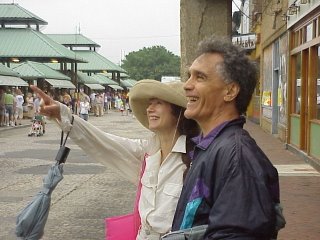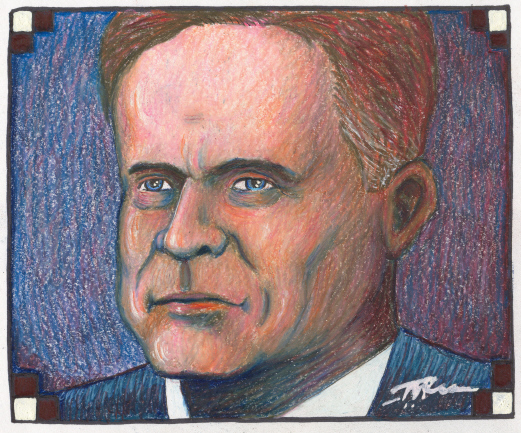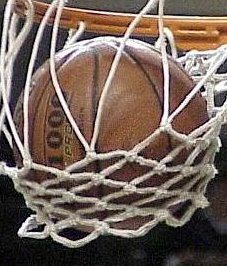fiction by F. T. ReaJune 3, 1959: Roscoe Swift, a lean boy with sandy hair and clear blue eyes, lived with his mother’s parents in their roomy stucco home in Dogtown, a suburb of Richmond, Virginia. His mother lived in her studio apartment over the garage, next to the breezeway, thirty yards from the house. She was a sometime commercial artist, who hadn’t ventured far from her studio/sanctuary in over a year. As a rule, she wouldn’t answer the door before noon.
When Roscoe was almost three-years-old his overly Southern mother, who was “rather delicately balanced” -- according to his grandmother -- left his father. As he never saw him again, Roscoe couldn’t remember much about the man, who went back in the Army and died fighting in Korea a couple of years after the separation. As his mother refused to speak of him, most of what Roscoe knew about his lost parent -- the body was never found -- came from his grandparents. That, and the peculiar look in his mother’s fretful brown eyes, which told him she was off, dwelling on what she had lost.
School was easy for Roscoe; when he could manage it, he took pride in being able to do the work as well as any other boy, but faster. But it was baseball that mattered to him more than anything else. He calculated and committed to memory the up-to-date batting averages of his favorite Major League players before he went to school, everyday.
At this point in his life, Roscoe’s only trouble at school was that his bad temper got him into fist fights, which not only earned him many a bloody nose, but it kept him from getting good grades in conduct.
For as long as Roscoe could remember, he had been in training to be a hero. He had tested his nerve with many a daredevil stunt and could throw a rock better than any boy in the neighborhood; any boy his age, anyway. At summer camp the year before, he had been the top rifle marksman in the whole camp, any age. Plus, he had listened attentively to all of his grandfather’s baseball yarns and coaching instructions.
Then came the day for his first true test -- it was, what was then, the biggest at-bat of the biggest game of his career.
The situation: Men were on first and third; one out; two runs behind in the bottom of the last inning. Taking his practice swings, Roscoe reminded himself of what the moment called for, baseball-fundamentals-wise.
“No grounder, no double play,” he thought, as he knocked red clay dust off his sneakers with the bat. “Drive it out of the infield.”
It was the last game of the season. Two of the school’s four fifth-grade classes had finished the year tied, forcing a playoff game to decide the championship. Following lunch, all the fifth-graders at Gittes Creek Elementary had been given the afternoon to watch the two teams settle the issue. Students with no taste for baseball had the option of watching a documentary film about Jamestown’s 350th anniversary.
Thus, there was a pretty good crowd for the title game.
A group of men, about a dozen of them, showed up. There were a couple of Little League coaches in the bunch, one of them had played Double A ball in his day. Several girls from the two classes involved were acting as cheerleaders. This was the first game Roscoe had ever played in that had cheerleaders.
Baseball, even fifth-grade baseball, was important business in Dogtown.
Roscoe stood in the batter’s box on the first base side of home-plate. A natural right-hander, Roscoe had decided that if the best hitter in the game -- Ted Williams -- batted left-handed, so would he. For a month he had been practicing swinging left-handed, almost exclusively, in neighborhood pickup games.
Finally, he had to test it in a game that mattered.
His best friend Finn Daley, standing on first base, cheered him on. Several of his teammates implored him from the bench to bat right-handed, as usual in so-called real games, since the season was on the line. Butterflies the size of eagles disquieted Roscoe’s stomach.
Stepping out of the box, the batter adjusted the dark blue wool baseball cap he wore when playing for his Little League team. He took three additional practice swings. He looked at the crowd on the third base line.
The cheerleaders were chanting, “Roscoe, Roscoe, he’s our man. If he can’t do it, nobody can.”
His architect grandfather, who had taken the afternoon off without it being an emergency -- for the first time in Roscoe’s memory -- stood in the shade of a large oak tree with three other men. Narrowing his gray eyes beneath the flat brim of his straw hat, the old man watched the batter’s body language as only he could.
On the first base line, his opponents and their fans booed and hooted at Roscoe. He decided to go far within himself, to dig in, to ignore them all.
However, there was a particular girl, with a strawberry-blonde ponytail and lively green eyes, cheering for the other team. Her name was Susie Ryan.
Roscoe always noticed Susie. This time was no exception. The best thing to say to her never came to mind when she was near. She made him nervous. So he watched her from a distance, mostly, with a sense of longing he couldn’t understand. Although Susie was calling for his downfall, Roscoe’s sharpshooter’s eyes followed her gestures. He was glad she was there.
Back in the box, Roscoe shifted his weight to his back foot and turned his front foot thirty degrees toward first base. Relaxing his fingers, he squinted his eyes and squared his jaw.
The pitcher threw the first pitch outside and in the dirt. It got by the catcher but the no-stealing ground rule didn’t allow the base-runners to advance.
Sure the next pitch would be across the plate, Roscoe prepared to cut the ball in half. The pitcher went into his stretch as the infielders behind him chattered encouragement.
Roscoe took a big roundhouse swing. Whoosh!
The ball disappeared in mid-air. Holding the baseball aloft, the catcher taunted, “Hey man ... looking for this?” Then he fired it back to the grinning pitcher.
Roscoe heard the collective laughter from his opponents and their classmates. Nonetheless, he didn’t look at anyone on either baseline. He knew he had shut his eyes while swinging the bat.
The batter’s cheeks flushed as he pulled his cap’s brim down on his brow.
“It only takes one to hit it!” Bellowed his grandfather through cupped hands.
Looking at the catcher’s signal, the pitcher nodded. Working from an exaggerated full stretch, he confidently cut loose with the same pitch -- a fastball.
Swinging from the heels, Roscoe rolled his wrists and tagged the ball: Cah-rack!
Traveling over the second baseman’s glove the sphere left the infield with dispatch. It was still rising when it split the seam between the right and center fielders. They chased it across the grass, then down the slope and all the way into the little trickle of a creek that bordered the school yard.
By far, it was the most solidly Roscoe had ever hit a baseball, and he knew it. The utter perfection of the bat’s perfectly-timed kiss on the horsehide’s sweet spot had resonated through his body -- it was a righteous sensation.
Circling the bases, Roscoe heard the growing furor. He ran like a monster was chasing him, rounding third, until he almost caught up with Finn.
“Slow down, Number Nine ... they haven’t even found it yet,” Finn advised with a laugh.
Roscoe’s euphoric classmates were jumping around wildly. His grandfather beamed as he waved his straw hat. Teammates, suddenly champions, were pounding him on his back as he neared home. Meanwhile, his capacity to comprehend the moment was red-lining.
He looked at Susie on the quiet side of the field. The way her head tilted to the side, the angle of her limbs, something about her backlit outline pulled him into a spell. When she stomped her foot it made everything he saw and felt become more intense, more vivid.
It was as though he was viewing the event from several different angles. Roscoe felt both inside and outside the scene, at its heart and yet detached. His mind raced and the rest of the world seemed to slow down. He strained to pull all the pictures together.
He alone heard the explosion ... boom!
For the first time in his eleven and a half years on the planet, all of life seemed perfectly in focus when Roscoe crossed home plate. His spirit was in flight. It was soaring, free of gravity, above his dogged fears.
It hadn’t occurred to him to lope around the bases, a la Ted Williams. He’d been too excited for such restraint. More importantly, he had remembered to make no showboating, hat-tipping gesture to the crowd. If the real Number Nine never tipped his cap to the public during his home run trot, well, that was more than good enough for Roscoe.
A genuine hero doesn’t have to tip his cap.
* * *
All rights reserved by the author.
This story is dedicated to Emily, my ten-year-old granddaughter





















